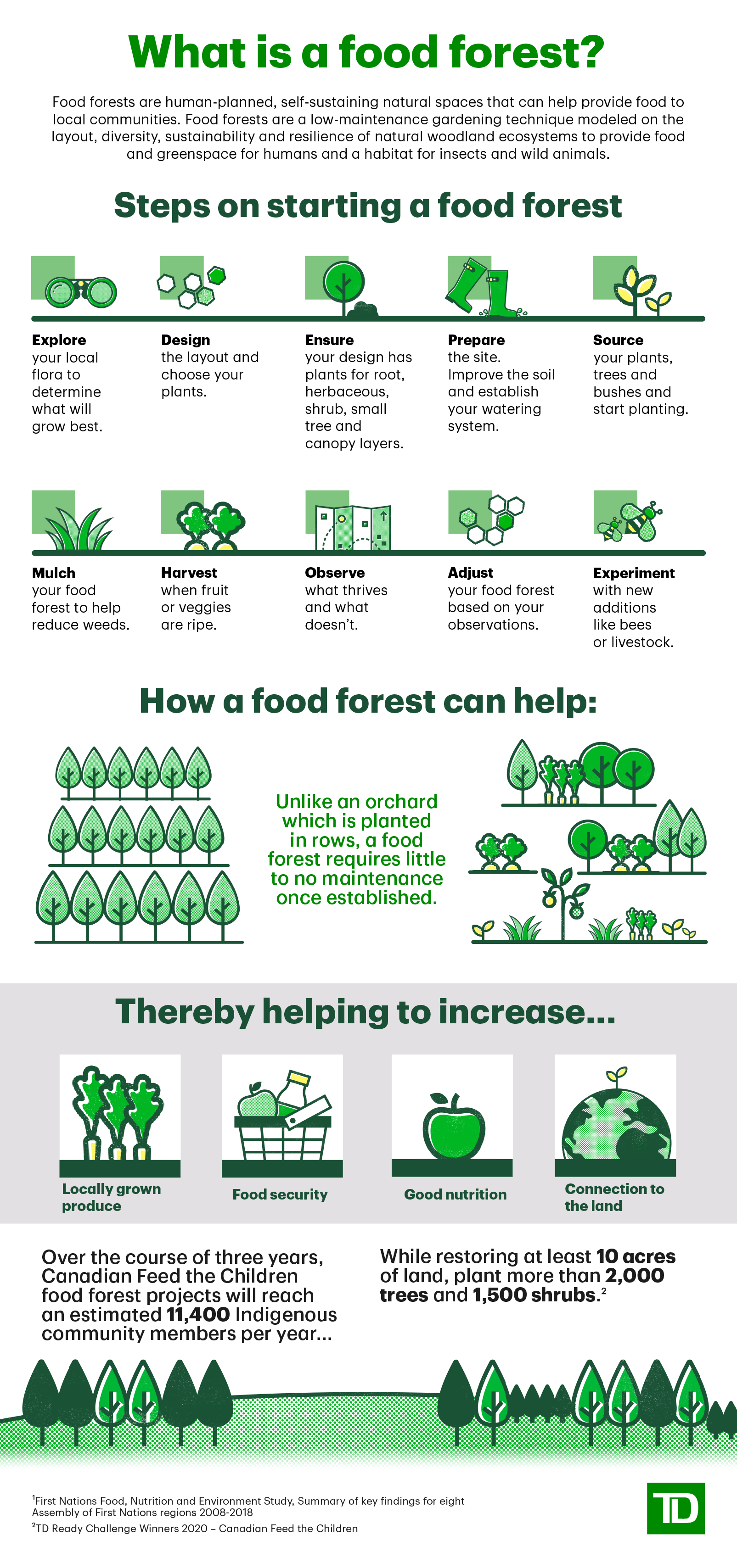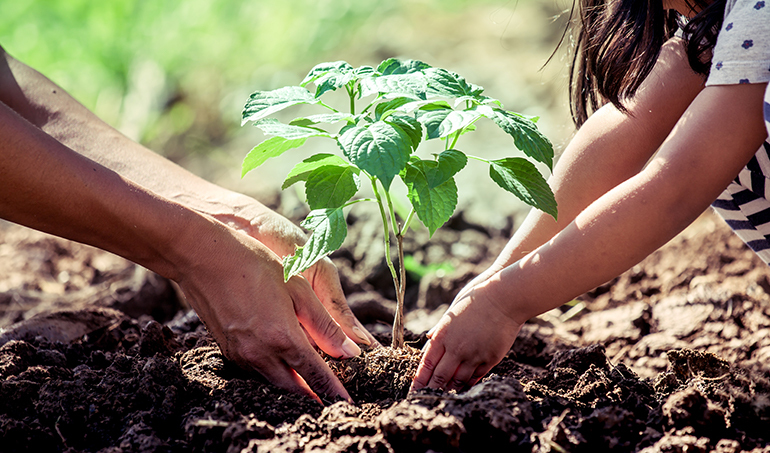For Glenna Cayen, caring for the environment and living off the land was a way of life for her ancestors.
However, the impacts of colonization stripped many Indigenous communities of their traditional relationship with the land. This disconnect coupled with modern agricultural practices and industrial farming has meant that many food production methods, hunting and harvesting practices, and valuable trading relationships between Nations were lost.
Now, as the food forest project coordinator with Canadian Feed the Children (CFTC), Cayen is helping revive some of these traditional practices, through the creation of permaculture food forests near three rural Indigenous communities in central Saskatchewan and Northern Alberta.
Food forests are human-planned, self-sustaining natural spaces that can help provide food to local communities. They are a low-maintenance gardening technique modeled on the layout, diversity, sustainability and resilience of natural woodland ecosystems using layers of trees, shrubs, perennials and annuals that work together to provide food and greenspace for humans and a habitat for insects and wild animals.
The price of healthy food in many Indigenous communities is much higher than in urban centers and due to their typically rural location, the quality of fresh produce in the local stores is often very low, or next to expiring, while the price tag is high. With high costs and scarce options, locals often face the impossible choice of quantity over quality when it comes to mealtime, which then ripples into larger negative health impacts for locals, and the community at large.
The goal for the forests is to eventually provide communities with sustainable access to higher quality, and/or more nutrient-dense healthy foods, enabling greater food security, better health for its members, the restoration of traditional food knowledge, as well as food-based entrepreneurial opportunities to strengthen economic independence.
"These practices are what have sustained us for thousands of years and reviving traditions of Indigenous Peoples not only helps us take care of the land, but ourselves too," said Cayen.
Traditional knowledge for the modern world
"Creating a food forest was important to my community members who worried that intensive agricultural development and land use practices, coupled with the impacts of climate change, could create land scarcity and chemical contamination of traditional food sources like berries, fruit trees and wild animals," said Cayen.
In 2018, Cayen led the Muskeg Lake Cree Nation pilot project, a food forest in her community with support from Canadian Feed the Children (CFTC) and funding from the TD Friends of the Environment Foundation.
Today, these innovative ideas have led to the creation of CFTC's TD Indigenous Forest Fund project, which in 2020 received a $1M CAD TD Ready Challenge grant. The Challenge is part of the Bank's corporate citizenship platform the TD Ready Commitment.
As part of this project, Cayen is supporting the creation of three new permaculture food forests located in Ahtahkakoop Cree Nation, Atikameg (Whitefish Lake First Nation) and Beardy's & Okemasis' Cree Nation.
"The answer to addressing hunger exists within Indigenous communities themselves," said Glenn Checkley, Program Manager at CFTC.
"We're here to help them access the funding needed to support the revival of the traditional knowledge and land-based practices that will help these communities realize a brighter, healthier future for their children and their land."

Click here for the accessible version.
Increasing greenspaces and reducing carbon
Jennifer Cameron, the food security worker in Beardy's & Okemasis Cree Nations, is also helping revive practices of Indigenous Peoples like fishing, hunting, gathering, and preserving food.
With the TD Ready Challenge grant they received and aimed at supporting COVID-19 recovery and building community resilience, Cameron and her team at Willow Creek Health are leading the new food forest project in Beardy's & Okemasis Cree Nation.
The food forest project in Cameron's community will turn a 1,000 x 150 -foot area into a permaculture food forest where currently unaffordable items, like fresh apples, will eventually be available for free to registered band members.
"Food forests can provide so much more than fruit and berries," said Cameron. "They grow to become beautiful greenspaces where locals can gather to eat, learn and play."
"Plating trees also helps remove carbon dioxide from the air," explains Cameron, who highlights the impact of food forests on fighting climate change. "In the long run, we hope we can reduce some of the carbon emissions created by transport trucks shipping in food by growing our own fruits and vegetables right where we live."
Growing healthy food and healthier communities
Just as a food forest is a reminder of the interconnectivity of all living things, its impact can also contribute to the mental and nutritional health of the community, as well as create economic opportunities.
"The incredible thing about food forests is that once they create significant yields, we can turn them into profits, like making and selling jams once the tourist corridor here re-opens," said Cameron.
She has also seen an increasing interest by community members in creating their own vegetable gardens, as well as learning to hunt, trap, skin, and prepare meat.
"We've done a lot of work already to create an intergenerational bridge using the food forest as a starting point," said Cameron.
"We consult our elders about local medicinal plants whose uses have been forgotten, and for their hunting knowledge and skills," said Cameron.
"The forest itself will also become an outdoor learning centre for our land-based and nutrition workshops, with benches and cooking areas where elders and children can come together and reconnect the threads of knowledge that have been broken. It's incredible to see how people light up when they are empowered with traditional knowledge and regain a strong connection with the environment."
Change starts with the children & Elders
With guidance from the Muskeg Lake Cree Nation Elders, the food forest pilot is already well on its way to becoming a fully sustainable ecosystem that is helping revive native plant species like rhubarb, cranberries, and saskatoon and haskap berries, along with medicinal plants like sage and sweetgrass.
At the same time, Cayen has seen proof of this positive change in her community, like youth using proper disposal bins and encouraging others to do the same.
"It’s a small but significant signal that the food forest project is having a positive impact on how our young community members relate to the environment."
In sum, the upcoming CFTC food forest projects will reach an estimated 11,400 Indigenous community members per year (both direct and indirect beneficiaries), see more than 2,000 trees and 1,500 shrubs planted, mobilize and train more than 120 new environmental stewards, and restore at least 10 acres of land.
Looking ahead, both Cameron and Cayen have big dreams for the future of their food forests.
"We've been working to strategize our crops with other communities for future trading opportunities," said Cayen.
"If we can leverage what grows well in all these different locations, we can build a trade network across Indigenous communities, just like our ancestors once did."
